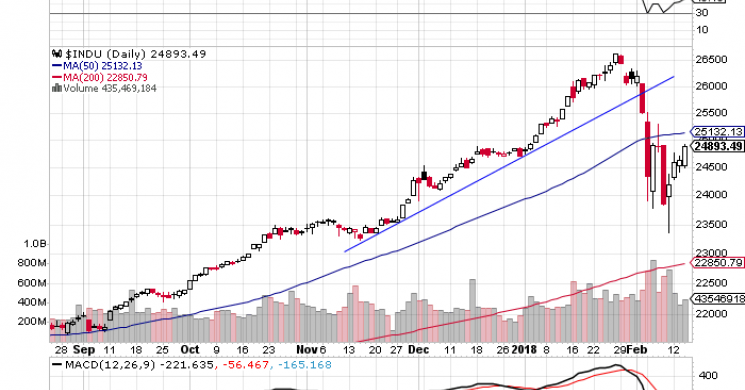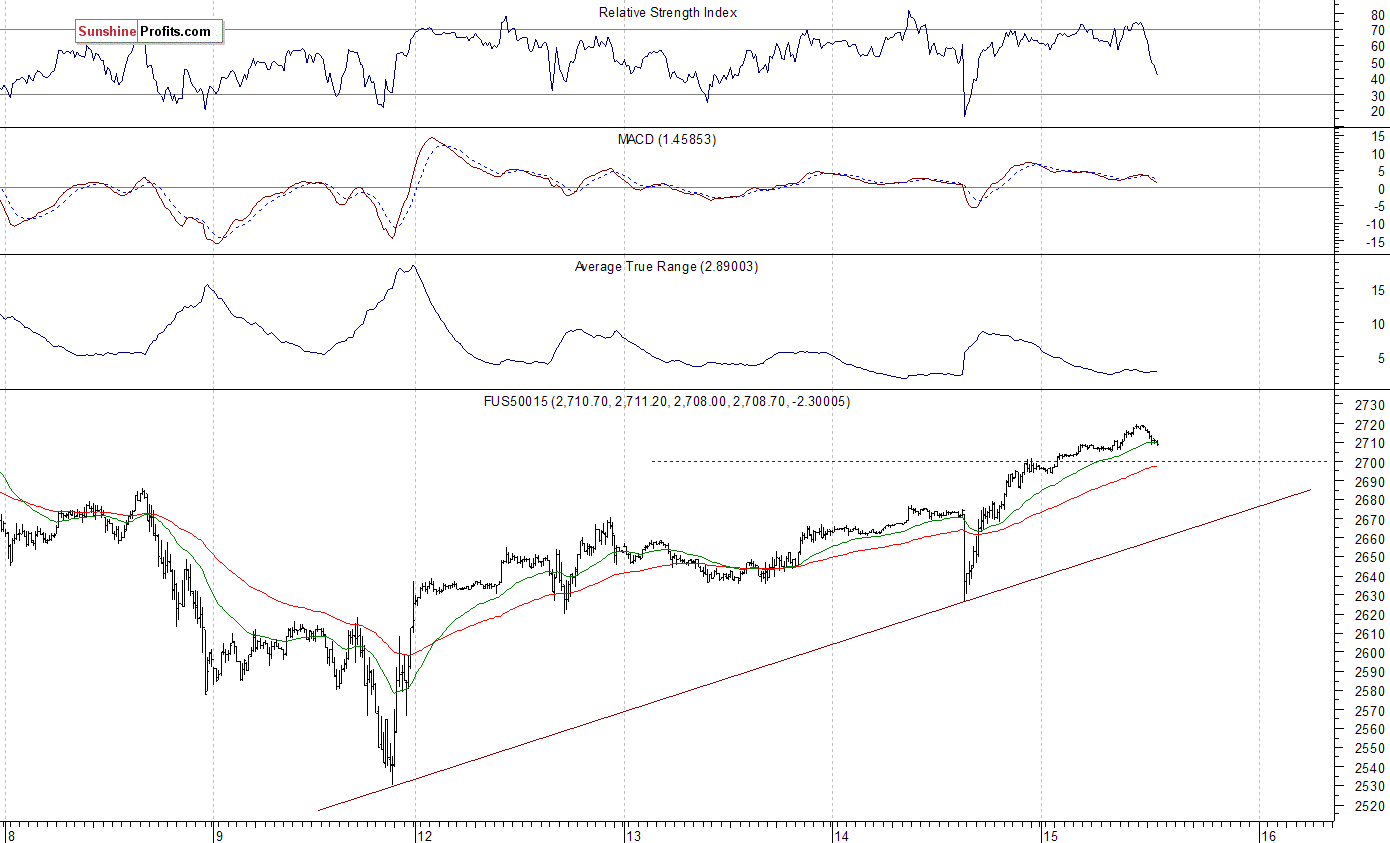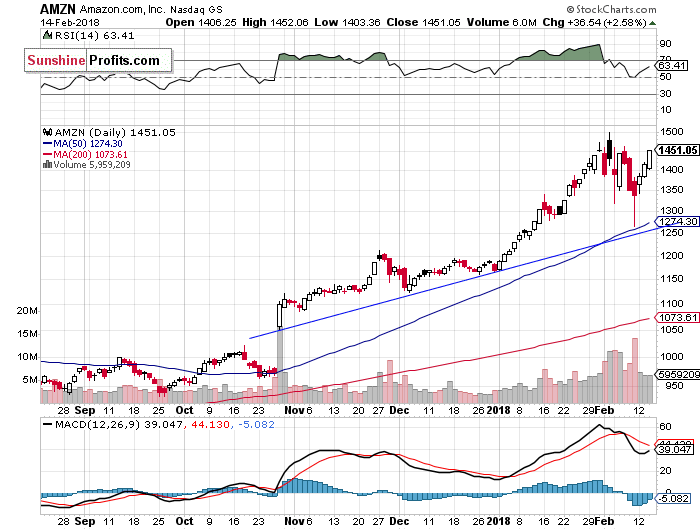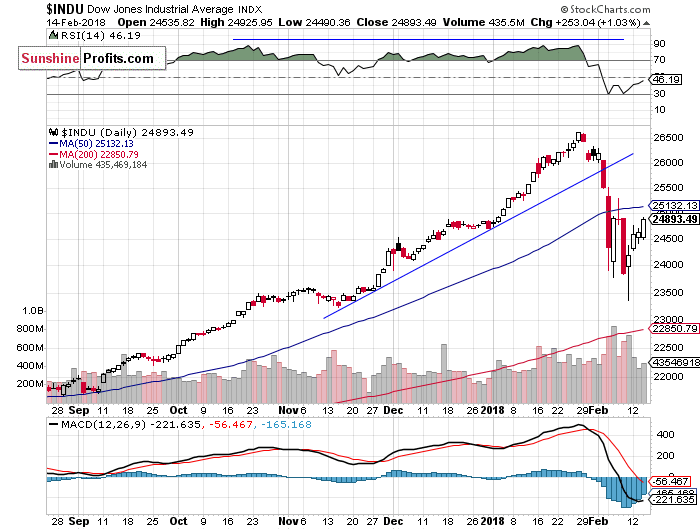
S&P 500 index gained 1.3% on Wednesday, following lower opening of the trading session. The market has extended its rally from Friday's low. But will it continue higher today? We can see some short-term overbought conditions. Was this two-week-long sell-off the beginning of a new medium-term downtrend or just downward correction before another leg up? It's hard to say, but this move down set the negative tone for weeks or months to come.
The U.S. stock market extended its short-term uptrend on Wednesday. The main indexes gained 1.0-1.9% following lower opening of the trading session. The S&P 500 index broke above its Monday-Tuesday trading range. The broad stock market gauge retraced most of its last week's Wednesday-Friday's sell-off, as it got close to 2,700 mark again. The Dow Jones Industrial Average gained 1.0%, and the technology Nasdaq Composite gained 1.9% yesterday.
The nearest important level of resistance of the S&P 500 index is now at 2,720-2,730, marked by last week's Wednesday's local high of 2,727.67. The next resistance level is at 2,740-2,760, among others. On the other hand, support level is at 2,640-2,650, marked by some recent local lows. The next level of support remains at 2,580-2,600, among others. The S&P 500 index is very close to the 50% retracement of the sell-off from record high of 2,872.87 (2702.78). The next important retracement of 61.8% is at 2,742.92.
The index reached its record high more than two weeks ago on Friday, January 26. It broke below month-long upward trend line on Tuesday, January 30 following gap-down opening of the trading session, confirming uptrend's reversal. Then the market retraced all of its January rally and continued lower. The index extended its downtrend on Friday, as it fell almost 12% below its late January record high. We can see that stocks are sharply reversing their medium-term upward course following the whole retracement of last month's euphoria rally. The market bounced off its almost year-long medium-term upward trend line on Friday, and it currently trades at its steeper, August-February upward trend line:

Positive Expectations
The index futures contracts trade 0.5-0.9% higher vs. their Wednesday's closing prices right now. It means that investors' expectations ahead of the opening of today's trading session are positive. The European stock market indexes have gained 0.5-1.4% so far. But will the sentiment remained that bullish after cash market opening at 9:30 a.m.? For now, it looks like the market may extend its short-term uptrend and continue its run above 2,700 mark. It may retrace the whole Wednesday-Friday's sell-off. Investors will wait for series of economic data announcements today: Producer Price Index, Empire State Manufacturing Index, Philadelphia Fed Manufacturing Index, Initial Claims at 8:30 a.m., Industrial Production, Capacity Utilization at 9:15 a.m., NAHB Housing Market Index at 10:00 a.m. Investors will also wait for more quarterly corporate earnings releases.
The S&P 500 futures contract trades within an intraday consolidation, as it fluctuates following breakout above the level of 2,700. The market sharply reversed its downward course yesterday after selling off before cash market opening. Investors reacted negatively to economic data release, but the futures contract came back and continued much higher. The nearest important level of support is now at 2,690-2,700, marked by some recent fluctuations. The next support level is at 2,670-2,680, marked by short-term local highs. On the other hand, level of resistance is at 2,725-2,730, marked by previous local high. The next resistance level is at 2,750-2,760, among others. The futures contract trades above 2,700 mark, as we can see on the 15-minute chart:

Nasdaq 100 Above 6,700 Mark Again
The technology Nasdaq 100 futures contract follows a similar path, as it trades within an intraday consolidation after yesterday's rally off its pre-session local low. The market broke above its short-term consolidation along the level of 6,550-6,570 yesterday. Then it broke above 6,700 mark. Will it continue higher? The nearest important level of resistance is at around 6,800, marked by previous local high. On the other hand, support level is at 6,680-6,700. The next level of support is at 6,550. The Nasdaq futures contract extends its short-term uptrend, as the 15-minute chart shows:

Let's take a look at Apple, Inc. stock (AAPL) daily chart (chart courtesy of http://stockcharts.com). It was one of the recent stock market rout's main drivers. The stock reached new record high a month ago following short-term consolidation along the support level of $175. The market got closer to $180 mark, but it failed to continue higher. Consequently, the stock retraced its January advance and continued lower. It broke its losing streak on Tuesday last week, but failed to reverse the downtrend. It fell close to support level of $150 on Friday. Then, it bounced and closed positive. The stock continued higher yesterday. Is this an upward reversal? For now, it looks like some relatively strong upward correction. The nearest important level of resistance is at around $165-170, and support level remains at $150-155:

Amazon.com, Inc. stock (AMZN) was relatively strong vs. the broad stock market recently. Despite an overall weakness, it was extending its month-long rally up until Friday over a week ago and its new record high at around $1,500 mark. The stock continues to trade well above its end of year closing price of $1,167.5. AMZN bounced off its upward trend line on Friday, following downward correction below the price of $1300. Will it continue towards new record highs? Depends on what the whole stock market does in the near future, but this stock continues to act pretty bullish:

The Dow Jones Industrial Average daily chart shows that blue-chip index broke below its short-term consolidation more than two weeks ago on Friday. The price sharply accelerated its downtrend on Monday, as it broke below the level of 25,500 and continued towards 24,000 mark. There were some medium-term negative technical divergences - the most common divergences are between asset’s price and some indicator based on it (for instance the index and RSI based on the index). In this case, the divergence occurs when price forms a higher high and the indicator forms a lower high. It shows us that even though price reaches new highs, the fuel for the uptrend starts running low.
The DJIA broke below its three-month-long upward trend line and retraced most of the November-January rally. Is this a new downtrend or still just correction? Last week's Tuesday's bounce was a first positive signal for the blue-chip market. We saw positive bullish piercing candlestick chart pattern. It is a pattern where the price literally pierces up through the falling market. However, the index struggled at the nearest important resistance level of 25,000, and reversed its short-term move up. Consequently, it fell below 24,000 mark again, and continued below 23,500 on Friday. We saw a positive candlestick chart pattern again on Friday. The market formed bullish harami. It is a pattern in which a large black candlestick is followed by a smaller white candlestick with body located within the body of a preceding day. Since then, it continued higher. However, the blue-chip index remains within its last week's Thursday's bearish trading range:

Concluding, the S&P 500 index broke above its short-term consolidation yesterday, as it extended its rally from Friday's local low of 2,532.69. The market reached 50% retracement of its move down from January 26 all-time high at 2,872.87. But will it continue higher? It may open higher, but we will probably see some short-term uncertainty and profit taking.
The broad stock market was retracing almost 12% off its late January record high on Friday, before an intraday reversal. Was this some final panic selling ahead of major upward reversal? Tuesday-Wednesday's rally was just "dead cat bouncing" upward correction. On Friday, we wrote that the market may find some short-term support at around its medium-term upward trend line, which was at 2,550. It came true, as the index bounced off support along the level of 2,530-2,550. The market extends the rebound from Friday's low, but it is still below its last Wednesday's local high.
The broad stock market retraced its whole month-long January rally and continued lower, the lowest since early October. So, medium-term picture is now bearish. Investors took profits off the table following the unprecedented month-long rally, but then they began selling in panic. It was quite similar to 2010 Flash Crash event. Is this just downward correction or the beginning of a new medium-term downtrend? This sell-off set the negative tone for weeks or months to come.
The S&P 500 index traded around 7.5% above its December 29 yearly closing price on Friday January 26. This almost month-long rally seemed unprecedented. The legendary investor John Templeton once said that "bull markets are born on pessimism, grow on skepticism, mature on optimism and die on euphoria”. So, now it looks like it was an euphoria phase of the nine-year-long bull market. Did it die over a week ago? It's hard to say, but new record highs scenario seems unlikely now.
If you enjoyed the above analysis and would like to receive free follow-ups, we encourage you to sign up for our daily newsletter – it’s free and if you don’t like it, you can unsubscribe with just 2 clicks. If you sign up today, you’ll also get 7 days of free access to our premium daily Gold & Silver Trading Alerts. Sign me up!
Thank you.
Paul Rejczak Stock Trading Strategist Stock Trading Alerts Sunshine Profits - Free Stock Market Analysis
Read more by MarketSlant Editor







